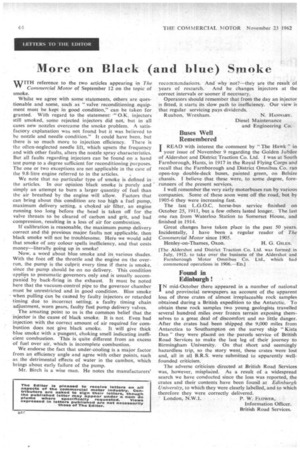More on Black (and blue) Smoke
Page 66

If you've noticed an error in this article please click here to report it so we can fix it.
WITH reference to the two articles appearing in The Commercial Motor of September 12 on the topic of smoke.
Whilst we agree with some statements, others are questionable and some, such as "valve reconditioning equipment must be kept in good condition," can be taken for granted. With regard to the statement: -" O.K. injectors still smoked, some rejected injectors did not, but in all cases new nozzles overcame the smoke problem. A satisfactory explanation was not found but it was beiieved to be nozzle and needle condition." It could have been, but there is so much more to injection efficiency. There is the often-neglected needle lift, which upsets the frequency and with other faults, alters the nozzle spray characteristics. But all faults regarding injectors can be found on a hand test pump to a degree sufficient for reconditioning purposes. The one or two exceptions are not applicable in the case of the 9.8-litre engine referred to in the articles.
We note that no particular type of smoke is defined in the articles. In our opinion black smoke is purely and simply an attempt to burn a larger quantity of fuel than the air breathed by the engine will allow. Factors that can bring about this condition are too high a fuel pump, maximum delivery setting, a choked air filter, an engine running too long before the head is taken off for the valve throats to be cleared of carbon and grit, and bad compression, resulting in a loss of air for combustion.
If calibration is reasonable, the maximum pump delivery correct and the previous major faults not applicable, then black smoke will not be troublesome. Here we would add that smoke of any colour spells inefficiency, and that costs money—literally going up in smoke!
Now, a word about blue .smoke and its various shades. With the foot off the throttle and the engine on the overrun, the pump is the culprit every time if there is smoke, since the pump should be on no delivery. This condition applies to pneumatic governors only and is usually accompanied by back-firing in the exhaust. It must be noted here that the vacuum-control pipe to the governor chamber must be unrestricted and in good condition. Blue smoke when pulling can be caused by faulty injectors or retarded timing due to incorrect setting, a faulty timing chain adjustment, worn gears, faulty fuel pump delivery valves.
The amazing point to us is the common belief that the injector is the cause of black smoke. It is not. Even bad injection with the correct amount of air required for combustion does not give black smoke. It will give thick blue smoke with a pungent, choking smell indicating inefficient combustion. This is quite different from an excess of fuel over air, which is incomplete combustion.
We endorse the fact that under-cooling is a major factor from an efficiency angle and agree with other points, such as the detrimental effects of water in the cam box, which brings about early failure of the pump.
Mr. Birch is a wise man. He notes the manufacturers' recoarnmdations. And why not?—they are the result of years of research. And he changes injectors at the correct intervals or sooner if necessary.
Operators should remember that from the day an injector is fitted, it starts its slow path to inefficiency. Our view is that regular servicing pays dividends.
Ruaban, Wrexham. N. HANNABv.
Diesel Maintenance and Engineering Co:
Buses Well Remembered
JREAD with interest the comment by ." The Hawk" in your issue of November 9 regarding the Golden Jubilee of Aldershot and District Traction Co. Ltd. I was at South Farnborough, Hants, in 1917 in the Royal Flying Corps and recall that the Farnborough and District Omnibus Co. ran open-top double-deck buses, painted green, on Belsize chassis. I believe that these were, to some degree, forerunners of the present services.
I well remember the very early motorbuses run by various companies. Some of these soon went off the road, but by 1905-6 they were increasing fast.
The last L.G.O.C. horse-bus service finished on October 25, 1911, but a few others lasted longer. The last one ran from Waterloo Station to Somerset House, and finished in 1914.
Great changes have taken place in the past 50 years. Incidentally, I have been a regular reader of The Commercial Motor since 1905.
Henley-on-Thames, Oxon. H. G. GILES.
[The Aldershot and District Traction Co. Ltd. was formed in July, 1912, to take over the business of the Aldershot and Farnborough Motor Omnibus Co. Ltd., which had commenced operations in 1906.—ED.]
Found in Edinburgh !
1N mid-October there appeared in a number of national and provincial newspapers an account of the apparent
loss of three crates of almost irreplaceable rock samples obtained during a British expedition to the Antarctic. To obtain these rock samples two young geologists travelled several hundred miles over frozen terrain exposing themselves to a great deal of discomfort and no little danger. After the crates had been shipped the 9,000 miles from Antarctica to Southampton on the survey ship Kista Dan" they were placed on the parcels service of British Road Services to make the last leg of their journey to Birmingham University. On that short and seemingly hazardless trip, so the story went, these crates were lost and, all in all B.R.S. were submitted to apparently wellfounded criticism.
The adverse criticism directed at British Road Services
was, however, misplaced. As a result of a widespread search we have conducted since the loss was reported, the crates and their contents have been found at Edinburgh University, to which they were clearly labelled, and to which therefore they were correctly delivered.
' London, N.W.1. P. W. FLOWER,








































































































